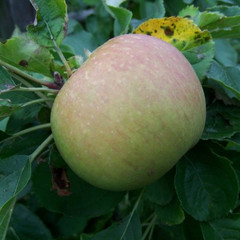Description
A more highly coloured sport of Belle de Boskoop. Received by the National Fruit Trials in 1950 from Denmark. Fruits have firm, coarse-textured flesh with a pleasant aromatic flavour. Cooks well.
"Known originally as Schone van Boskoop, and thought to be a bud sport spotted in 1856 by Mr Ottolander, of Boskoop, Netherlands, who observed a branch of particularly fine fruits on a Reinette de Montfort. Although It received an RHS Award of Merit in 1897, British Pomologists did not list it before 1920, when Bunyard considered it worthy of trial as a commercial cultivar. Its value in this respect has long been known in continental Europe, and it has been grown commercially in Holland, Belgium, Germany, Poland, Romania and the former USSR; it is also cultivated in Canada, Australia, New Zealand, and in the USA, where some connoisseurs consider it an outstanding fruit. A healthy, very hardy and productive tree, good in wet areas, a good choice for commercial culture, well suited to organic culture, could do well to serve farmers' markets. It is very attractive in bloom.
Most descriptions do not do justice to the flavour, which is usually said to be rather acid; tangy and aromatic would serve better. Eaten fresh as a dessert apple, it is crisp, juicy and firm, and it makes an excellent juice with a high vitamin C content (16mg/100g). It is also used for cider. It is an excellent cooker, for sauce, apple butter, and for baking, since it keeps its shape. It cooks down to a thick, fluffy golden purée, which makes a firm, piquant filling for pies, needing little or no additional sugar, and is superb as a base for a tarte with almonds and apricots, or when decorated with segments of a second apple, such as Nancy Jackson. This dense purée makes an excellent breakfast treat, served with yoghourt and a few fat sultanas." © Lin Hawthorne - 'The Northern Pomona'.
For help with choosing the correct rootstock for your needs, please click here A Guide to Rootstocks
For help with choosing the correct size and shape, please click here A Guide to Fruit Tree Shapes







